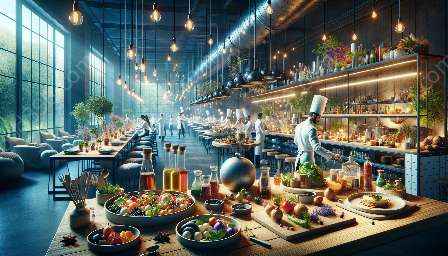Food presentation and plating have evolved beyond just serving a meal; it is an art form that enhances the overall dining experience, blending creativity, science, and gastronomy. In both gastronomy and culinology, the visual appeal of a dish plays a crucial role in enticing the senses—taste, smell, and even touch—enhancing the enjoyment and appreciation of food.
Understanding Food Presentation and Plating
Food presentation and plating in gastronomy refer to the visual arrangement of dishes on a plate, incorporating aesthetics, balance, and creativity to enhance the appeal of the meal aesthetically. In culinology, it extends to the science and techniques behind the presentation, taking into account factors like color, texture, and portion sizes.
The Impact on Perception and Enjoyment
Research has shown that the visual appeal of a dish significantly influences the perception of its taste and can affect the overall dining experience. By utilizing various plating techniques and presentation styles, chefs can captivate diners' attention and elevate their dining experience, adding an element of surprise and delight to each dish.
The Role of Gastronomy and Culinology
In gastronomy, presentation and plating are instrumental in expressing the chef's creativity and showcasing the cultural and regional influences of a dish. On the other hand, culinology emphasizes the scientific aspect, exploring the ways in which food presentation can affect consumer behavior and satisfaction, applying principles of food science and psychology to create visually appealing and gastronomically delightful plates.
Techniques and Styles
There are numerous techniques and styles employed in food presentation and plating, such as:
- Minimalist: Emphasizing clean lines and simple arrangements to highlight the natural beauty of the ingredients.
- Geometric: Using precise cuts and placements to create visually stunning, symmetrical designs.
- Rustic: Showcasing a more natural, casual style by arranging food in an artfully disheveled manner to evoke an authentic, homely feel.
- Artistic: Incorporating creative touches, such as edible flowers and decorative elements to transform dishes into culinary works of art.
Innovation and Creativity
Gastronomy and culinology encourage chefs and food professionals to explore innovative presentation techniques, incorporating new technologies and tools to push the boundaries of traditional plating styles. By merging creativity and scientific understanding, they can create visually stunning and culturally immersive dining experiences that engage all the senses.
Challenges and Considerations
While food presentation and plating offer endless opportunities for creativity, chefs and culinologists must also consider practical aspects such as logistical constraints in a commercial kitchen, the impact of transportation on the presentation, and the maintenance of food safety standards while experimenting with novel techniques and designs.
The Future of Food Presentation and Plating
As gastronomy and culinology continue to evolve, the focus on food presentation and plating is expected to intensify. With a growing appreciation for visually captivating dining experiences and an increasing demand for immersive culinary adventures, the art of food presentation will undoubtedly play a pivotal role in shaping the future of the food industry.


